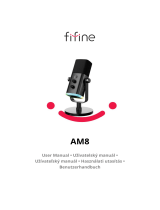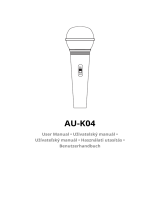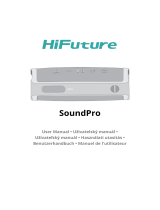fifine K688 Benutzerhandbuch
- Kategorie
- Musikausrüstung
- Typ
- Benutzerhandbuch

K688
User Manual • Uživatelský manuál •
Užívateľský manuál • Használati utasítás •
Benutzerhandbuch

2
English
3 – 20
Čeština
21 – 38
Slovenčina
39 – 56
Magyar
57 – 74
Deutsch
75 – 92

3
Dear customer,
Thank you for purchasing our product. Please read the following instructions carefully
before first use and keep this user manual for future reference. Pay particular attention
to the safety instructions. If you have any questions or comments about the device,
please contact the customer line.
www.alza.co.uk/kontakt
✆ +44 (0)203 514 4411
Importer Alza.cz a.s., Jankovcova 1522/53, Holešovice, 170 00 Prague 7, www.alza.cz

4
What’s in the box?
• 1 x Microphone with Shock Mount
• 1 x 6.56” Type C USB Cable
• 1 x 5/8” Male to 3/8” Female Adapter
• 1 x Tripod Stand
• 1 x User’s Manual
Product Description
1. Microphone Capsule – Dynamic microphone element with cardioid polar pattern.
2. Detachable Windscreen – Offers maximum protection from plosive breath noise.
Could be removed by unscrewing the base of the windscreen and gently pulling.
3. Microphone Volume Control – Control the sound of the mic.
4. Headphone Volume Control – Control the sound of the headphone.
5. Mute Button and LED Indicator – Tap to mute or unmute the mic. If the light is
green, the mic is active, if the light is red, the mic is muted.
6. USB-C Output – Connect directly to your computer via the included USB cable.

5
7. XLR Output-Connect to interface phantom power, mixer or audio interface with
XLR cable (excluded).
8. Headphone Jack – 1/8 inch (3.5 mm) stereo jack for monitoring your voice in real
time.
9. Shock Mount – Isolate the mic and supress the sound of unintentional rumbles
are bumps.
10. USB Cable (6.56”) – Type A to Type C USB cable. (Only the included USB cable is
100% guaranteed for compatibility)
11. 5/8” Male to 3/8” Female Screw Adapter – For connecting the mic to boom arm
stand (not included) if needed.
12. Tripod Stand (bonus)
Guidance for use
1. We suggest to attach the mic to a boom arm stand using the included 5/8” male
to 3/8* female adapter to get the best effect. (The boom arms is not included)
For USB C Port Connect
1. Fully plug the included USB cable into the USB C Port at the bottom of the mic.

6
2. Plug the USB connector to the computer.
For XLR Port Connect
1. Fully plug the excluded XLR cable into the XLR Port at the bottom of the mic.
2. Plug the XLR cable male end to the equipment with phantom power
requirements, and then plug the equipment connector to the computer
(equipment with phantom power requirement and computer excluded).
3. Aways keep the top of the mic facing the audio source.

7
Mute Button
Tao the button to mute / unmute the mic.
Make sure the LED light is green when you are going to use the mic.
Headphone Output
The K688 mic includes a standard 1/8” (3.5mm) headphone jack for monitoring and
playback.
Plug the headphone to the 3.5.mm jack at the bottom of the mic if you want to monitor
your voice in real time. Choose this mic “FIFINE Microphone” as the input device of your
computer if you want to monitor your voice mixed with the sound from computer.
Note:
1. Make sure to plug your headphone into the headphone jack of microphone fully.
Red = Microphone is muted
Green = Microphone is on

8
2. When the mic is on (the mute button indicates green) and the mic gain is not
turned to zero, you will hear your voice at once. No need to login any recording
software (Apple-Macintosh systems) or click “listen to this Device”. (Windows
systems)
Apple MAC OS
1. Hook up the mic to computer. The mute button indicates green, means the mic is
on. Your computer will automatically install the driver of the mic. There may be
no pup-up message reminding this process though.
2. Go to the System Preferences.
3. Click Sound to display the Sound preference pane.

9
4. Click the Input tab and select the “FIFINE Microphone” as the device for sound
input.
5. Output Settings
1) Output the audio from the mic
Plug the headphone to the 3.5mm jack at the bottom of the mic if you want to
monitor your voice mixed with the sound from mac.
2) Output the audio from Mac
1. The mic will become the default output device automatically when it plugs into
the Mac. If you want to listen to the sound from the built-in speaker of the mac
directly, please choose the “Internal Speakers” as output device.

10
2. If you wan to connect your earphone to Mac and listen to the sound, please
select the Headphones as output device.
Windows
Input settings
Hook up the mic to computer. The mute button indicates green, means the mic is on.
Your computer will automatically install the driver of the mic. There may be no pup-up
message reminding this process though.
1. Right click the speaker icon at the bottom right of the screen. Click “Sounds” or
“Open Sound Settings”.

11
2. Click the Sound control panel.
3. Click the Recording tab, and choose “FIFINE Microphone” as the default device.
When you speak into mic, the volume meter will turn green and bounce. If it
remains unchanged, please reset the computer and replug the mic in the
available USB ports of the computer.

12
4. Adjust input volume – Double click the “FIFINE Microphone” to open the
Microphone Properties window and click the Levels tab. Drag the progress bar to
adjust the mic level. (You can also turn the mic gain up or down by adjusting the
knob on the mic)
Output settings
1) Output the computer audio from the mic
1. Plug the headphone to the 3.5mm jack at the bottom of the mic if you want to
monitor your voice in real time. Click the “Playback” tab from the Sound pane,
select “FIFINE Microphone” as the default output device if you want to monitor
your voice mixed with the computer audio.

13
2. Click the Speaker (FIFINE Microphone) – Properties – Levels, and drag progress
bar to adjust output volume.
(Make sure the speaker and the microphone are active under the Levels tab.)
2) Output the audio from the computer
a. The will become the default output device automatically when it is plugged into
the computer. If you want to listen to the sound from the built-in speaker of the
computer directly, please click the “Playback” tab from the Sound pane and
choose “Realtek Hight Definition Audio” as the default output device.

14
b. If you want to connect the headphone to the computer and listen to the sound,
please select the Headphone as output device.
3. Click the speaker that is being used – Properties – Levels, drag the progress bar to
adjust volume of output.
Note: (Applicable for MAC and Windows)
1. If the computer prompts that it’s unable to identify this USB devices, please
restart computer and replug the mic into other USB port.
2. If the mic is recognized but no sound coming out, please check whether System
Sound is mute and whether you have turned the knob on the mic to minimum.
Make sure the LED indicator is green (means the microphone’s on)
3. If your computer runs windows, please check off the box “Listen to this device”
when you are using any recording software (such as Audacity) of chatting
software (such as Skype), otherwise you would hear double audio just like echo.
Click the “Recording” tab and click the FIFINE Microphone – Properties – Listen – check
off the box “Listen to this device” – Apply.

15
4. If your computer runs windows 10, please go to settings > privacy > microphone
and click the Allow apps to access the microphone to ON then restart.
Recording Software Settings
1. Please “FIFINE Microphone” as the input device from the settings when using
recording software. Take the Audacity for example.
If you monitor your audio from headphone jack of computer, please select “Headphone
(Realtek (R) Audio)” as output device. If you monitor from the mic headphone jack, select
the FIFINE Microphone as output.
Input: FIFINE Microphone

16
Note: If the recording software (such as Audacity) doesn’t recognize the mic, please
log out the software, replug the mic in the computer and launch the software again.
Then the mic will be in the drop down option of input device.
2. Make sure the check off the box “Listen to this device” from the sound system
when you are using any recording software, or else you would hear duet of
yourself just like too much echo.
3. There are several ways to improve the usage. Come to our website to search the
Technical Support solution for your interested subject.
4. For windows computers, we recommend to use Audacity. For Apple computers,
you can use the QuickTime Player to test recording.
Important Notice
• Setting the volume levels
Correct adjustment of microphone level is important for optimum performance.
Ideally, the microphone level should be as high as possible without overloading
the input of your computer. If you hear distortion, or if your recording program
shows levels that are consistently overloaded (at peak levels), turn the
microphone gain (or level) down, either through the knob on the mic, the system
settings, or through your recording software. If your recording program shows
insufficient level, you can increase the microphone gain either through the knob
on the mic, the system settings, or through your recording software.
• Selecting software
Many recording software can be chosen. Audacity, available for free online is
widely used software. If you plug in the mic AFTER you load Audacity, it may not
recognize the mic while it may still record, the results will be unsatisfactory. If
that happens, restart Audacity AFTER plugging the USB into your computer and
click on Fifine Microphone option.
• Positioning your microphone
To achieve the best frequency response, it is important to have the mic capsule
(the top of the mic) pointed at the user’s mouth, instrument, or any other sound
source. The best range is 2 to 4 inches.
Output: Pls choose correct output

17
• Protecting your microphone
Avoid leaving your microphone in the open air or in areas where temperature
exceed 110°F (43°C) for extended periods. Extremely high humidity should be
avoided.
Choose your output setting
When you plug microphone to your PC, it cancels the audio from any other audio file
played or there’s no sound on the playback, you need to manually select the “speaker
(Realtek High-Definition Audio”) as the default playback device, if you want to output
computer audio via the computer built-in speaker.
K688 is dynamic microphone, all function buttons are only active when connected with
TYPE-C. When using the XLR interface to record, the function buttons don’t work.
Specification
Type
Dynamic
Polar Pattern
Cardioid
Port
USB-Type-C and XLR
Power Supply
5±0.25V
S/N Ratio
>75dB
Sensitivity
-74±3dB

18
Warranty Conditions
A new product purchased in the Alza.cz sales network is guaranteed for 2 years. If you
need repair or other services during the warranty period, contact the product seller
directly, you must provide the original proof of purchase with the date of purchase.
The following are considered to be a conflict with the warranty conditions, for
which the claimed claim may not be recognized:
• Using the product for any purpose other than that for which the product is intended
or failing to follow the instructions for maintenance, operation, and service of the
product.
• Damage to the product by a natural disaster, the intervention of an unauthorized
person or mechanically through the fault of the buyer (e.g., during transport,
cleaning by inappropriate means, etc.).
• Natural wear and aging of consumables or components during use (such as
batteries, etc.).
• Exposure to adverse external influences, such as sunlight and other radiation or
electromagnetic fields, fluid intrusion, object intrusion, mains overvoltage,
electrostatic discharge voltage (including lightning), faulty supply or input voltage and
inappropriate polarity of this voltage, chemical processes such as used power
supplies, etc.
• If anyone has made modifications, modifications, alterations to the design or
adaptation to change or extend the functions of the product compared to the
purchased design or use of non-original components.

19
EU Declaration of Conformity
Identification data of the manufacturer's / importer's authorized representative:
Importer: Alza.cz a.s.
Registered office: Jankovcova 1522/53, Holešovice, 170 00 Prague 7
CIN: 27082440
Subject of the declaration:
Title: Microphone
Model / Type: K688
The above product has been tested in accordance with the standard(s) used to
demonstrate compliance with the essential requirements laid down in the
Directive(s):
Directive No. 2014/30/EU
Directive No. 2011/65/EU as amended 2015/863/EU

20
WEEE
This product must not be disposed of as normal household waste in accordance with
the EU Directive on Waste Electrical and Electronic Equipment (WEEE - 2012/19 / EU).
Instead, it shall be returned to the place of purchase or handed over to a public
collection point for the recyclable waste. By ensuring this product is disposed of
correctly, you will help prevent potential negative consequences for the environment
and human health, which could otherwise be caused by inappropriate waste handling of
this product. Contact your local authority or the nearest collection point for further
details. Improper disposal of this type of waste may result in fines in accordance with
national regulations.
Seite laden ...
Seite laden ...
Seite laden ...
Seite laden ...
Seite laden ...
Seite laden ...
Seite laden ...
Seite laden ...
Seite laden ...
Seite laden ...
Seite laden ...
Seite laden ...
Seite laden ...
Seite laden ...
Seite laden ...
Seite laden ...
Seite laden ...
Seite laden ...
Seite laden ...
Seite laden ...
Seite laden ...
Seite laden ...
Seite laden ...
Seite laden ...
Seite laden ...
Seite laden ...
Seite laden ...
Seite laden ...
Seite laden ...
Seite laden ...
Seite laden ...
Seite laden ...
Seite laden ...
Seite laden ...
Seite laden ...
Seite laden ...
Seite laden ...
Seite laden ...
Seite laden ...
Seite laden ...
Seite laden ...
Seite laden ...
Seite laden ...
Seite laden ...
Seite laden ...
Seite laden ...
Seite laden ...
Seite laden ...
Seite laden ...
Seite laden ...
Seite laden ...
Seite laden ...
Seite laden ...
Seite laden ...
Seite laden ...
Seite laden ...
Seite laden ...
Seite laden ...
Seite laden ...
Seite laden ...
Seite laden ...
Seite laden ...
Seite laden ...
Seite laden ...
Seite laden ...
Seite laden ...
Seite laden ...
Seite laden ...
Seite laden ...
Seite laden ...
Seite laden ...
Seite laden ...
-
 1
1
-
 2
2
-
 3
3
-
 4
4
-
 5
5
-
 6
6
-
 7
7
-
 8
8
-
 9
9
-
 10
10
-
 11
11
-
 12
12
-
 13
13
-
 14
14
-
 15
15
-
 16
16
-
 17
17
-
 18
18
-
 19
19
-
 20
20
-
 21
21
-
 22
22
-
 23
23
-
 24
24
-
 25
25
-
 26
26
-
 27
27
-
 28
28
-
 29
29
-
 30
30
-
 31
31
-
 32
32
-
 33
33
-
 34
34
-
 35
35
-
 36
36
-
 37
37
-
 38
38
-
 39
39
-
 40
40
-
 41
41
-
 42
42
-
 43
43
-
 44
44
-
 45
45
-
 46
46
-
 47
47
-
 48
48
-
 49
49
-
 50
50
-
 51
51
-
 52
52
-
 53
53
-
 54
54
-
 55
55
-
 56
56
-
 57
57
-
 58
58
-
 59
59
-
 60
60
-
 61
61
-
 62
62
-
 63
63
-
 64
64
-
 65
65
-
 66
66
-
 67
67
-
 68
68
-
 69
69
-
 70
70
-
 71
71
-
 72
72
-
 73
73
-
 74
74
-
 75
75
-
 76
76
-
 77
77
-
 78
78
-
 79
79
-
 80
80
-
 81
81
-
 82
82
-
 83
83
-
 84
84
-
 85
85
-
 86
86
-
 87
87
-
 88
88
-
 89
89
-
 90
90
-
 91
91
-
 92
92
fifine K688 Benutzerhandbuch
- Kategorie
- Musikausrüstung
- Typ
- Benutzerhandbuch
in anderen Sprachen
- English: fifine K688 User manual
- slovenčina: fifine K688 Používateľská príručka
Verwandte Papiere
Sonstige Unterlagen
-
 fifne AM8 AmpliGame Dynamic Mic Benutzerhandbuch
fifne AM8 AmpliGame Dynamic Mic Benutzerhandbuch
-
 MAONO K01 Benutzerhandbuch
MAONO K01 Benutzerhandbuch
-
Baseus WKWG000003 Benutzerhandbuch
-
Baseus CAHUB-BG0G Benutzerhandbuch
-
Sony DR-EX230DP Bedienungsanleitung
-
CHOETECH XCM-1501 Benutzerhandbuch
-
Trust 5.1 Surround USB Benutzerhandbuch
-
 Ravcore DYNAMITE Instructions For Use Manual
Ravcore DYNAMITE Instructions For Use Manual
-
Gioteck EX-06 Benutzerhandbuch
-
 HiFuture SoundPro Bluetooth Speaker Benutzerhandbuch
HiFuture SoundPro Bluetooth Speaker Benutzerhandbuch
































































































